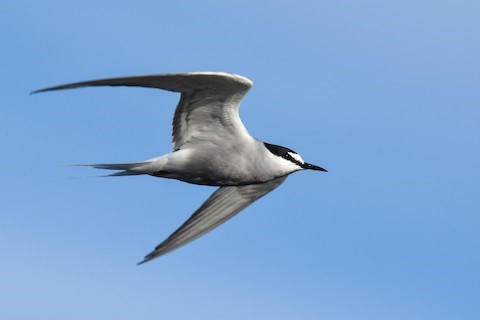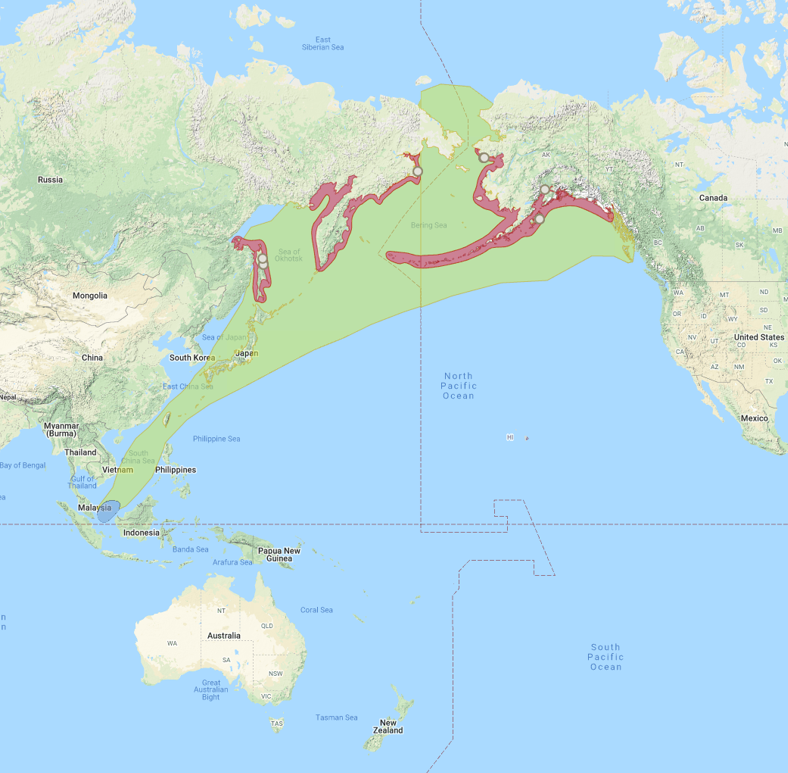Birdfinding.info ⇒ Locally common in summer on its Alaskan breeding grounds, where the most readily accessible nesting colonies are on the Kenai Peninsula at Anchor Point and Homer. More remote colonies are scattered along Alaska’s coasts at sites that include the Copper River Delta, Nome, Glacier Bay, and Kalsin Bay on Kodiak Island. In winter a few have been found annually since 2016 at Old Bar in New South Wales, Australia. On migration, in April, May, and September, it has been found regularly at Hong Kong (usually a short distance offshore) and at coastal sites and at sea around Taiwan.
Aleutian Tern
Onychoprion aleuticus
Breeds in eastern Russia and Alaska. Winters from Indonesia to eastern Australia.
Breeding. Breeds from late May to July in colonies that are usually located in freshwater marshes along coasts, where it typically forages in nearby marine waters.
In Alaska, breeds from Kotzebue south to the Alaska Peninsula and Aleutians, and east along the North Pacific to Glacier Bay.
Russian breeding areas are along the Bering Sea from Anadyr to Kamchatka and around the Sea of Okhotsk, including Sakhalin.
Nonbreeding. Winter range is poorly understood, but thought to lie within the marine waters of Indonesia and Australia.
There are midwinter records from east and south of Sulawesi and along the eastern coast of Australia (at the mouth of Manning River in New South Wales).
Movements. Northbound migrants have been found in March and April in Indonesia, the Philippines and along the Malay Peninsula, then in April and May along the southeastern coast of China and Taiwan. It apparently flies directly from these areas to its breeding grounds in mid-May, as it is rarely reported from the central Chinese coast, Korea, and Japan, despite extensive coverage in these areas.
After breeding, it departs promptly from its colonies and disperses around the Bering Sea and Sea of Okhotsk. Southbound migrants reappear in southeastern China, Taiwan, and the Philippines as early as late August, but mainly during September.
Seems to occur regularly in small numbers during September and October west to the Gulf of Siam and more generally in coastal waters of Southeast Asia and Indonesia.
Identification
A medium-small tern with a black bill and feet and distinctive breeding plumage: mostly gray above and below, with a black cap, white forehead and black eyestripe.

Aleutian Tern, breeding plumage. (Kachemak Bay, Alaska; May 30, 2017.) © Donna Pomeroy
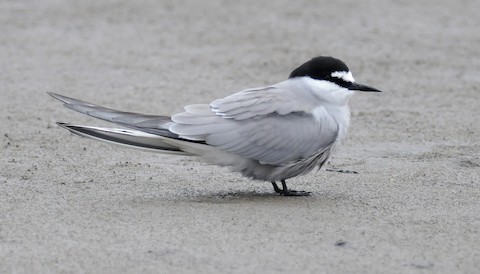
Aleutian Tern, breeding plumage. (Adak Island, Alaska; May 30, 2008.) © Steven Mlodinow
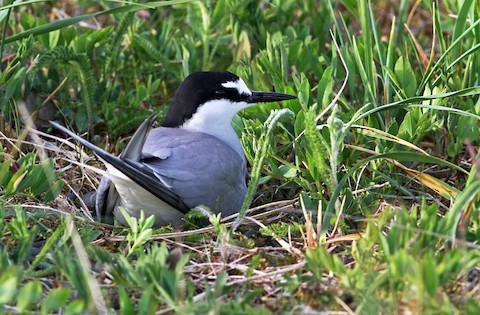
Aleutian Tern, on nest. (Kalsin Bay, Kodiak Island, Alaska; June 16, 2013.) © Andrew Spencer

Aleutian Tern, breeding pair. (Nome, Alaska; June 3, 2019.) © Mel Senac
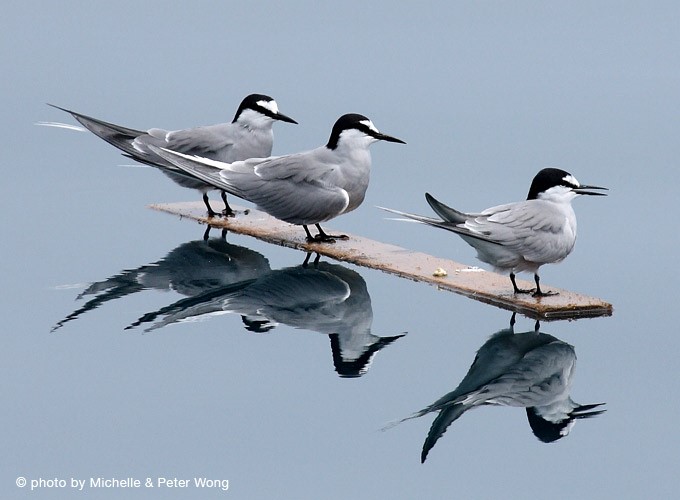
Aleutian Tern, breeding plumage. (Offshore from Po Toi Island, Hong Kong; May 1, 2008.) © Michelle & Peter Wong
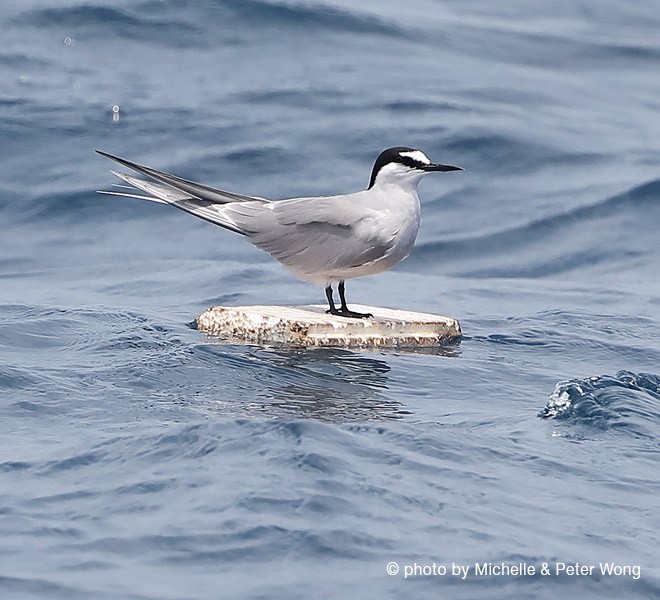
Aleutian Tern, breeding plumage. (Offshore from Po Toi Island, Hong Kong; May 11, 2017.) © Michelle & Peter Wong
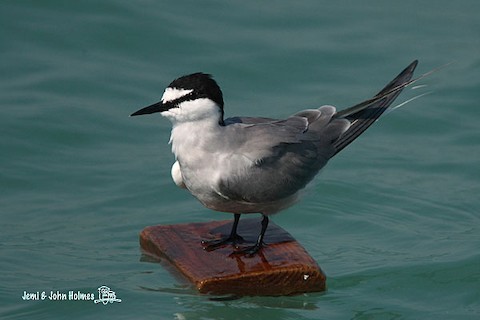
Aleutian Tern, breeding plumage. (Hong Kong; May 15, 2006.) © Jemi & John Holmes

Aleutian Tern, breeding plumage. (Offshore from Po Toi Island, Hong Kong; May 1, 2008.) © Michelle & Peter Wong
The wings have a distinctive pattern that is visible mainly in flight from below: whitish overall with a blackish trailing edge on the secondaries and outer primaries—but not on the inner primaries, so the trailing edge has white space in the middle.
The same pattern can sometimes be seen on the uppersides of the wings. More typically, the uppersides appear medium-gray overall, except that the outer primaries are a darker shade of gray—blackish when folded.

Aleutian Tern, breeding plumage. (Kalsin Bay, Kodiak Island, Alaska; June 16, 2013.) © Andrew Spencer
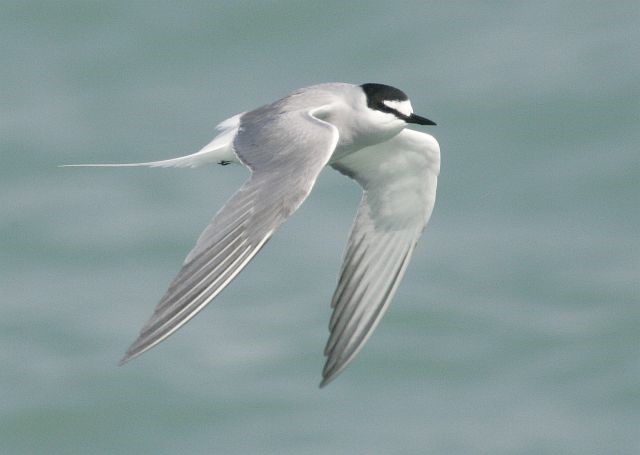
Aleutian Tern, breeding plumage. (Hong Kong; May 18, 2006.) © Martin Hale

Aleutian Tern, breeding plumage. (Offshore from Po Toi Island, Hong Kong; May 11, 2017.) © Michelle & Peter Wong

Aleutian Tern, breeding plumage. (Nome, Alaska; June 29, 2019.) © Brian Sullivan

Aleutian Tern, breeding plumage. (Nome, Alaska; June 29, 2019.) © Brian Sullivan
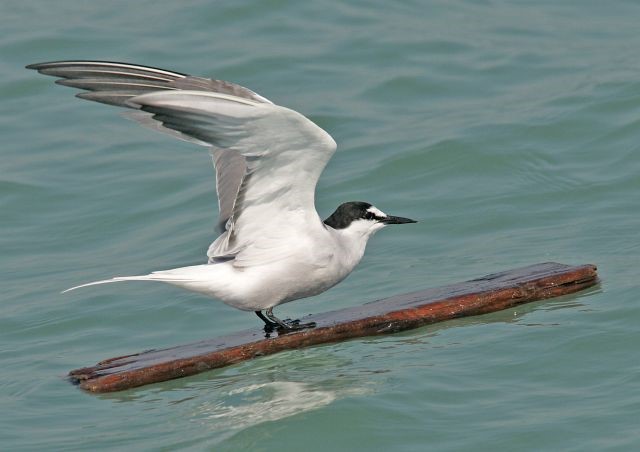
Aleutian Tern, breeding plumage. (Hong Kong; May 18, 2006.) © Martin Hale

Aleutian Tern, breeding plumage. (Hong Kong; May 15, 2006.) © Jemi & John Holmes

Aleutian Tern, breeding plumage. (Nome, Alaska; June 5, 2017.) © Robert Bowker

Bridled Tern, O. a. anaethetus, showing a white collar. (Sai Kung, Hong Kong; July 9, 2020.) © Ryan Yue Wah Chan

Aleutian Tern, breeding plumage. (Nome, Alaska; June 8, 2015.) © Tom Johnson

Aleutian Tern, breeding plumage. (Nome, Alaska; June 28, 2019.) © Steve Kelling

Aleutian Tern, breeding plumage. (Nome, Alaska; June 8, 2015.) © Tom Johnson
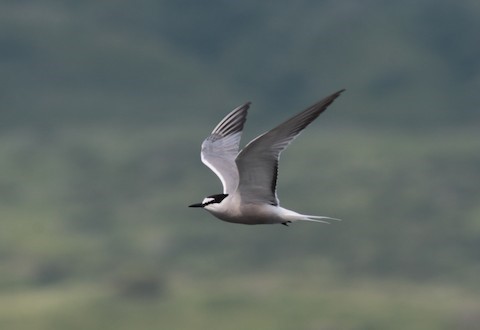
Aleutian Tern, breeding plumage. (Kalsin Bay, Kodiak Island, Alaska; July 31, 2019.) © Richard MacIntosh

Aleutian Tern, breeding plumage. (Nome, Alaska; June 17, 2019.) © Tom Johnson

Aleutian Tern, breeding plumage. (Nome, Alaska; June 3, 2019.) © Mel Senac

Aleutian Tern, breeding plumage. (Offshore from Po Toi Island, Hong Kong; May 11, 2017.) © Michelle & Peter Wong

Aleutian Tern, breeding plumage. (Nome, Alaska; June 28, 2019.) © Brian Sullivan

Aleutian Tern, breeding plumage. (Nome, Alaska; June 28, 2019.) © Brian Sullivan
Nonbreeding Plumages. Nonbreeders resemble other terns more than breeding adults. Their underparts turn white and their head pattern is reduced to a smudged, blackish hindcrown or cowl (much like nonbreeders of several other species).
Nonbreeders’ most distinctive feature is visible only in flight: as in breeding plumage, nonbreeders show a blackish trailing edge on the secondaries and outer primaries, with a gap between them. The pattern is clearer on the underside, but often discernible on the upperside as well.

Aleutian Tern, nonbreeding plumage. (Offshore from Po Toi Island, Hong Kong; September 28, 2008.) © Michelle & Peter Wong

Aleutian Tern, nonbreeding plumage. (Offshore from Bagan Sungai Buluh, Selangor, Malaysia; November 16, 2013.) © Ang Teck Hin

Aleutian Tern, nonbreeding plumage. (Old Bar, New South Wales, Australia; December 20, 2017.) © Roksana & Terry

Aleutian Tern, nonbreeding plumage. (Old Bar, New South Wales, Australia; December 4, 2018.) © Michael Rutkowski
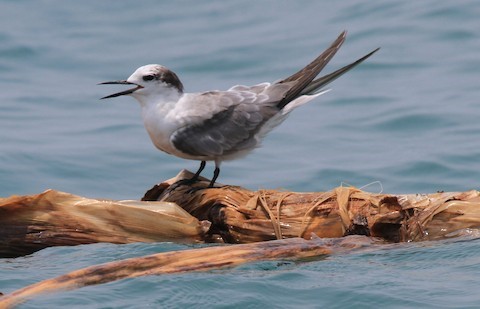
Aleutian Tern, nonbreeding plumage. (Krakatoa, Indonesia; September 29, 2011.) © Fabio Olmos,

Aleutian Tern, nonbreeding plumage. (Tanjung Tokong, Penang, Malaysia; October 6, 2006.) © Dave Bakewell

Aleutian Tern, nonbreeding plumage. (Old Bar, New South Wales, Australia; February 28, 2018.) © Liam Murphy

Aleutian Tern, nonbreeding plumage. (Old Bar, New South Wales, Australia; January 9, 2019.) © Greg McKay
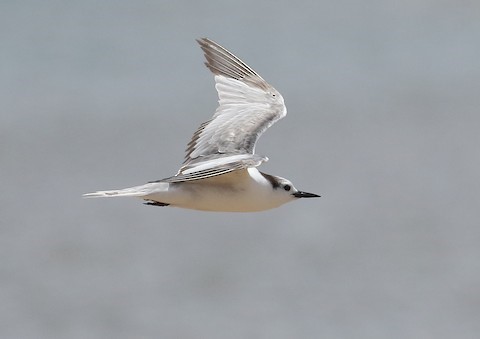
Aleutian Tern, nonbreeding plumage. (Old Bar, New South Wales, Australia; December 4, 2018.) © Michael Rutkowski

Aleutian Tern, nonbreeding plumage. (Old Bar, New South Wales, Australia; December 4, 2018.) © Michael Rutkowski

Aleutian Tern, nonbreeding plumage. (Offshore from Singapore; September 21, 2019.) © Francis Yap
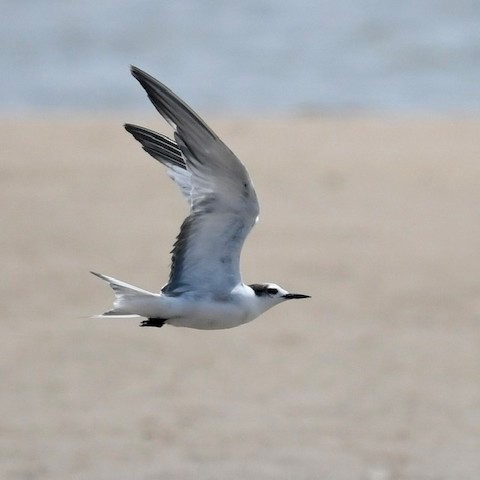
Aleutian Tern, nonbreeding plumage. (Old Bar, New South Wales, Australia; November 21, 2020.) © Mike Barrow

Aleutian Tern, nonbreeding plumage. (Old Bar, New South Wales, Australia; December 11, 2017.) © Liam Murphy

Aleutian Tern, nonbreeding plumage. (Old Bar, New South Wales, Australia; December 22, 2017.) © Chris Wiley
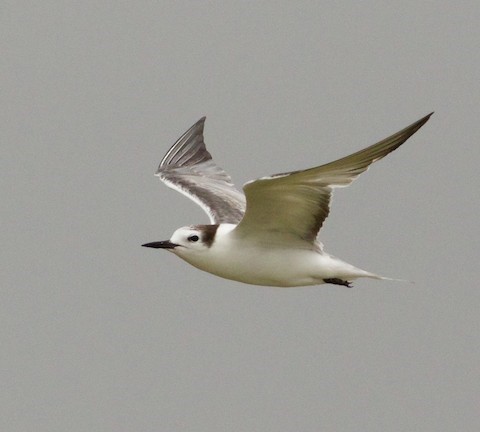
Aleutian Tern, nonbreeding plumage. (Old Bar, New South Wales, Australia; December 15, 2017.) © Scott Baker

Aleutian Tern, nonbreeding plumage. (Old Bar, New South Wales, Australia; December 11, 2017.) © Liam Murphy
Immature Plumages. Juveniles bear little resemblance to adults. They have pink feet, a mostly pinkish bill, and largely brown-and-buffy upperparts.
Older immatures quickly lose the brown, buffy, and pink tones. Instead, they have black bills and feet, and their upperparts are strongly patterned with shades of pale and dark-gray.
Like all adult plumages, immatures in flight also show a dark trailing edge on the secondaries.

Aleutian Tern, immature. (Offshore from Po Toi Island, Hong Kong; September 28, 2008.) © Michelle & Peter Wong

Aleutian Tern, juvenile. (Port Moller, Alaska; July 24, 2014.) © Nat Drumheller

Aleutian Tern, juvenile. (Port Moller, Alaska; July 24, 2014.) © Nat Drumheller

Aleutian Tern, juvenile. (Lake Rose Tead, Kodiak Island, Alaska; July 30, 2015.) © Robin Corcoran
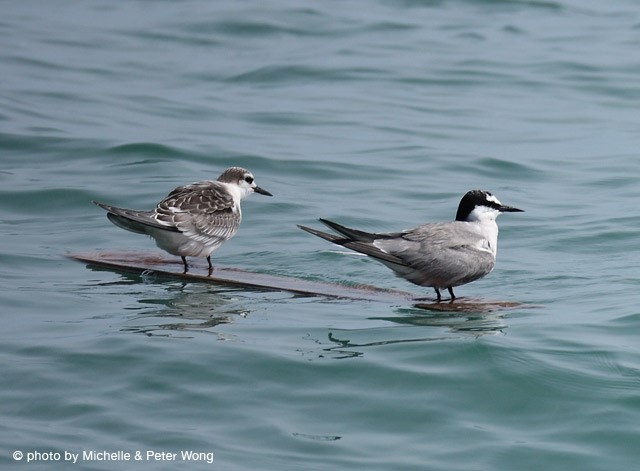
Aleutian Tern, immature and adult. (Offshore from Po Toi Island, Hong Kong; September 28, 2008.) © Michelle & Peter Wong
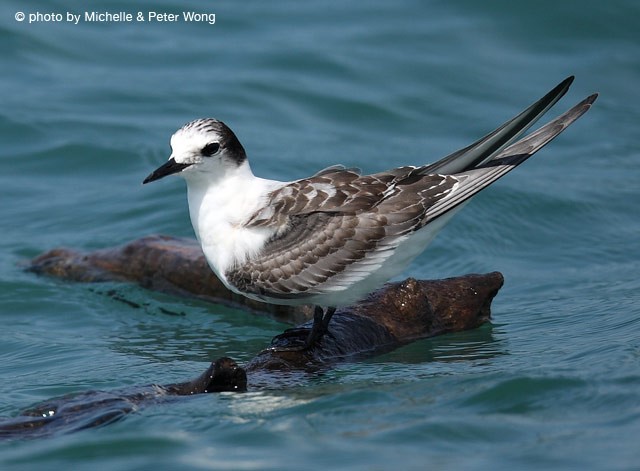
Aleutian Tern, immature. (Offshore from Po Toi Island, Hong Kong; September 28, 2008.) © Michelle & Peter Wong

Aleutian Tern, juvenile. (Vorovskaya River Lagoon, Kamchatka Krai, Russia; August 13, 2016.) © Ric Else
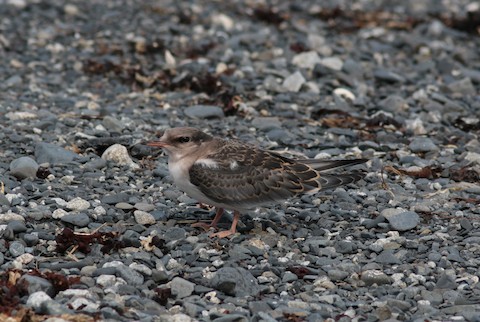
Aleutian Tern, juvenile. (Kalsin Bay, Kodiak Island, Alaska; July 31, 2019.) © Richard MacIntosh

Aleutian Tern, juvenile in flight—showing dark trailing edge on the secondaries. (Kalsin Bay, Kodiak Island, Alaska; July 31, 2019.) © Richard MacIntosh
Cf. Gray-backed Tern. Gray-backed and Aleutian Terns potentially overlap in the tropical Pacific and could mistaken for one another—especially in breeding plumage as they have similar head patterns and both have medium-gray upperparts. They differ in several respects.
The most reliable distinguishing feature is the shape of the white patch on the forehead. Aleutian’s white patch fully covers the forehead and ends at the eye, whereas Gray-backed has a thin white “visor” with white brow-stripes that extend behind the eye.
On the upperparts, Gray-backed’s back and tail are both gray overall, whereas Aleutian has a contrasting all-white tail. On the underparts, Gray-backed is all-white, whereas Aleutian is pale-gray from the chest to the belly, with a contrasting white throat and white underwings.
Notes
Monotypic species.
IUCN Red List Status: Vulnerable.
References
Alderfer, J., and J.L. Dunn. 2014. National Geographic Complete Birds of North America. National Geographic Society, Washington, D.C.
BirdLife International. 2018. Onychoprion aleuticus. The IUCN Red List of Threatened Species 2018: e.T22694716A132569526. https://dx.doi.org/10.2305/IUCN.UK.2018-2.RLTS.T22694716A132569526.en. (Accessed December 1, 2020.)
Brazil, M. 2009. Birds of East Asia. Princeton University Press.
eBird. 2020. eBird: An online database of bird distribution and abundance. Cornell Lab of Ornithology, Ithaca, N.Y. http://www.ebird.org. (Accessed December 1, 2020.)
Harrison, P. 1983. Seabirds: An Identification Guide. Houghton Mifflin, Boston.
Sibley, D.A. 2000. The Sibley Guide to Birds. Alfred A. Knopf. New York.
Xeno-Canto. 2020. Aleutian Tern – Onychoprion aleuticus. https://www.xeno-canto.org/species/Onychoprion-aleuticus. (Accessed December 1, 2020.)
